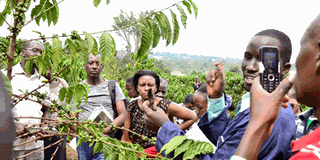Best practices of coffee planting

Lumu (2ndR) explains the agronomy of Robusta coffee during the Monitor Farm Clinic at Kabanyolo recently. PHOTOS BY ALEX ESAGALA
What you need to know:
- Leguminous cover crops like soybeans, groundnuts and non-climbing phaseolus beans, among others can be intercropped in newly planted coffee up to two years, writes Christine Katende
Many coffee farmers are not keen when it comes to planting and management of the crop.
However, Moses Lumu, a coffee agronomist and consultant says that when choosing an area to establish a coffee farm, a farmer should consider several requirements such as rainfall, soil, temperature, topography and altitude for the selected type.
Robusta
Robusta coffee requires an altitude from 800-1500 metres above sea level. The topography should be from a flat to a gentle sloping land.
The temperature should be between 18-27 degrees Celsius, rainfall between 1200-1500mm per year and the soil should be deep (1 m before reaching impermeable soil), free draining (after rain or irrigation), sandy loam and rich in organic matter. It should be well aerated and with pH 5.5 to 7.5.
Arabica
Arabica coffee requires an altitude from 1300-2300 metres above sea level. The topography should be from a flat to a gentle sloping land.
The temperature should be between 15-24 degrees Celsius with rainfall between 1200-1500milimetre per year distributed in nine months.
Lumu says the soil should be deep (one metre before reaching impermeable soil), free draining (after rain or irrigation), sandy loam and reach in organic matter. It should be well aerated and with pH 4.5 to 6 (slightly acidic).
Spacing, digging and covering holes
The expert advises as follows: .Robusta coffee is planted at a spacing of 10 by 10 feet while Arabica is planted at 8 by 8 feet.
.The holes for both types should be two by two feet (diameter x depth) three months before planting. This is to enable soils loosen for better water and root penetration.
.Separate the top soil from sub-soil which is infertile when digging the holes.
.A month to planting, farmers must refill the holes with top soil and mix soil with a 20-litre basin decomposed manure in each hole.
“Add SSP, DAP or TSP fertiliser at 75 grammes (a handful) per hole if available because phosphorus is good for root development,” says Lumu. .Cover the hole to slightly above ground level to allow for settling that may follow rain.
Mark a position in the center of the hole where the plant will be planted using a peg.
Planting
According to Lumu, plant the coffee two to four weeks after the onset of rains. “Water the seedling in the evening for planting the next day and if possible water them on spot after planting,” he notes, recommending the following;
.On planting, open up the centre of filled holes enough to fit the entire root system of the coffee seedling then trim off twisted roots and those protruding beyond the pot.
.Remove polythene pots before planting. Carefully loosen the soil surrounding the seedling by breaking it to ease water up take and root development.
.Gently place the plant in the opening, their collars should be at level with the surrounding soil or a bit higher to allow sinking and cover the seedling with soil and place the soil to firm the seedling.
.Put temporary shade on newly planted coffee to protect it from direct sun for its early days.
“Use materials such as palm leaves or tree branches which do not grow and must not rest on the coffee and regularly inspect the planted field to identify dead plants and replace them, intercropping and shade,” he advises.
Lumu emphasises that leguminous cover crops like soybeans, groundnuts and non-climbing phaseolus beans, among others can be intercropped in newly planted coffee up to two years.
If intercropped with bananas, plant at a ratio of four coffee trees to one banana, (banana at 20 by 20feet in Robusta and 16 by 16feet in Arabica starting from the middle of four plants at the beginning of the garden).
He adds that you may plant semi-permanent shade of leguminous shrubs such as carriandra, flamingia, tephrosia between every fourth row of coffee and around the edges of the plantation.
Permanent shade trees such as albizzia spp (migavu), ficus spp (mutuba, mucusu), cordia africana can be planted at a spacing of 15 by 15metres or 20 by 20metres.
Fruit trees such as avocado, mangoes and jackfruit can also be used. The best would be to plant shade trees before establishing coffee.
“The importance of shade is to reduce weed growth, soil temperature, water loss from the coffee trees, leaves that fall from shade trees act as mulch and roots bring up nutrients that may have leached to the sub-soil and protect coffee trees from being broken by heavy wind (act as windbreaks),” he says, adding, “Remember to always reduce on the shade by trimming the shade trees. Trim off shade tree branches which grow close to coffee as they prevent its normal growth.”




